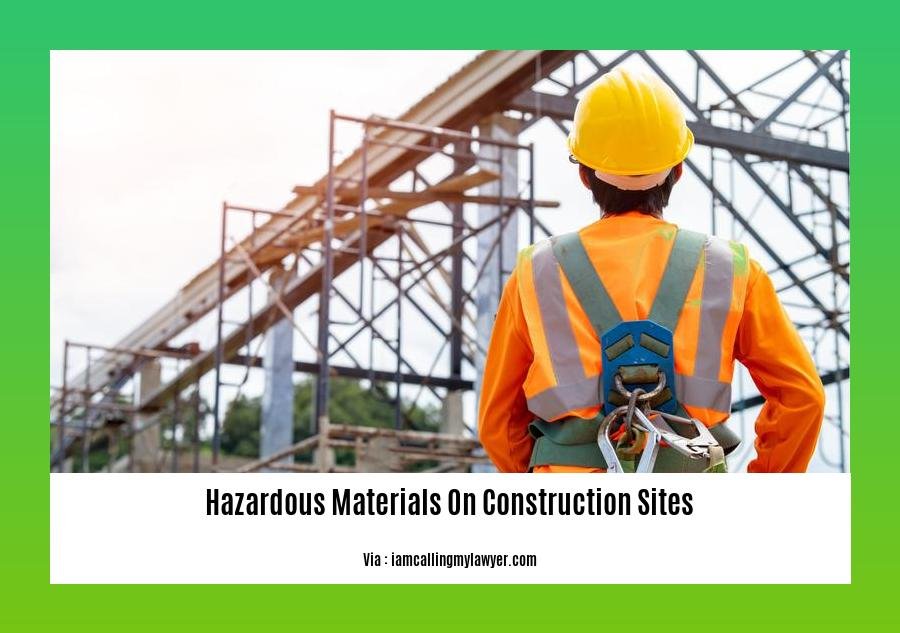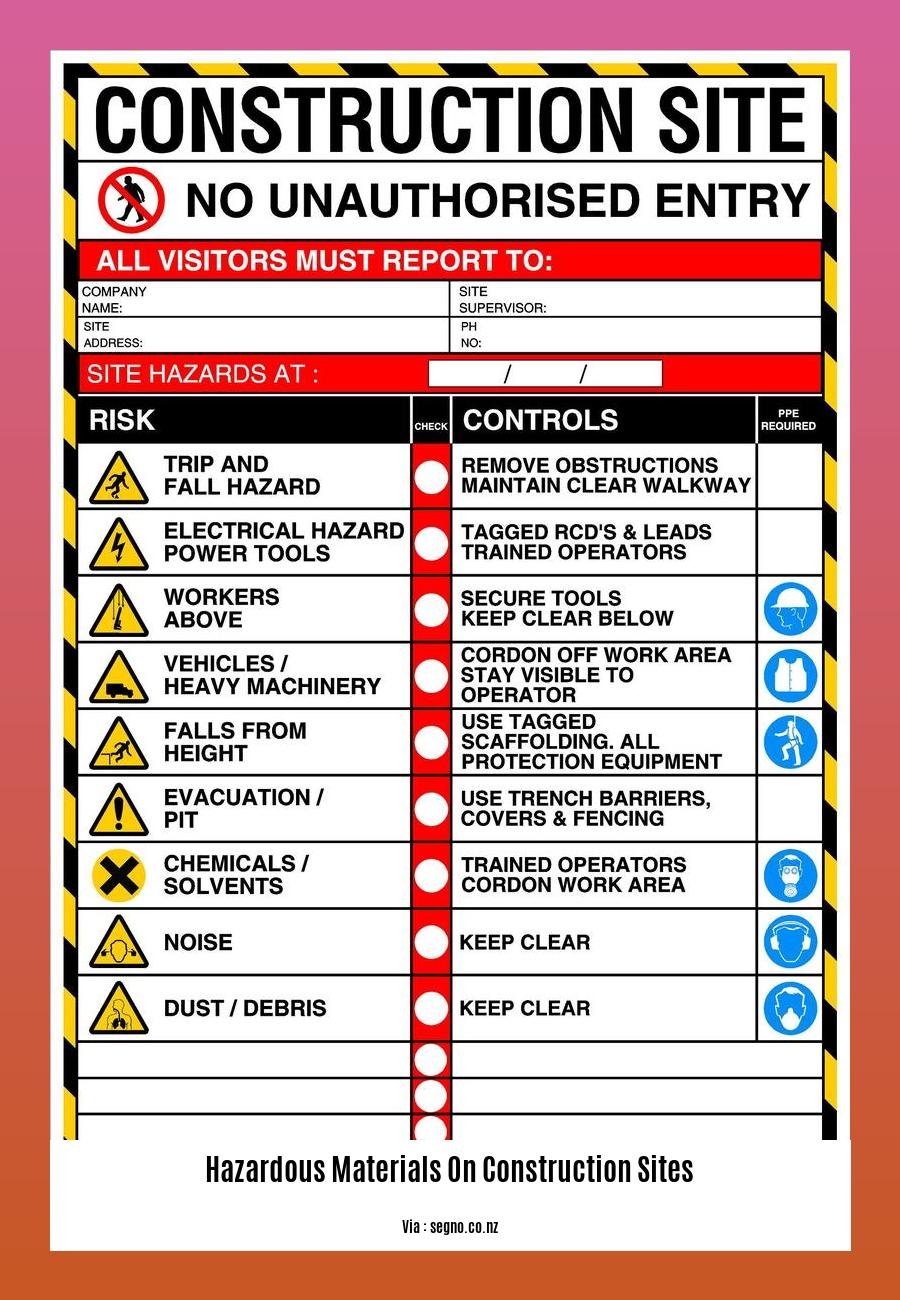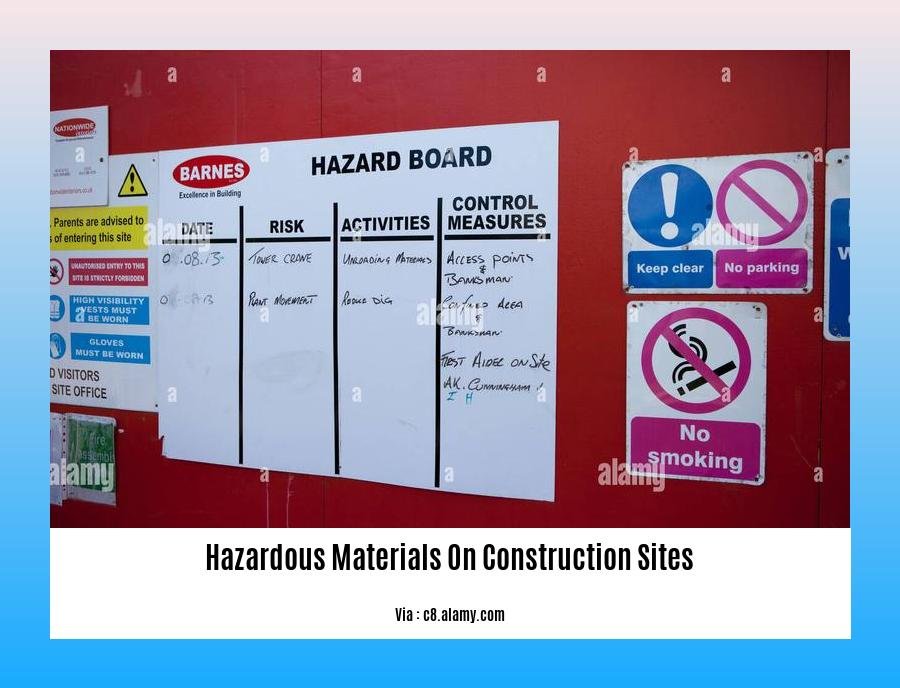Properly managing hazardous materials on construction sites is a critical aspect of ensuring the safety of workers, the public, and the environment. This comprehensive guide, Managing Hazardous Materials on Construction Sites: A Critical Safety Guide, provides industry professionals with the essential knowledge and guidance to effectively identify, assess, and mitigate the risks associated with hazardous materials.
Key Takeaways:
-
Construction workers are at risk of exposure to hazardous materials, including:
- Asbestos
- Lead
- Silica dust
- Gases and vapors
- Solvents
- Carbon monoxide
-
These materials can be present in different forms:
- Dust, fumes, and fibers
- Liquids and mists
- Gases and vapors
-
Exposure to hazardous materials can occur through inhalation, skin contact, or ingestion.
Hazardous Materials on Construction Sites: Critical Safety Concerns

Understanding the Risks
Construction sites often harbor various hazardous materials on construction sites that pose significant health hazards to workers and the environment. Knowledge of these materials and their health impacts is crucial for ensuring safety.
Common Hazardous Materials
- Asbestos: In older buildings, exposure to asbestos fibers can cause lung cancer, mesothelioma, and asbestosis.
- Lead: Found in paint and plumbing, lead exposure can lead to neurological damage and learning disabilities.
- Silica: Dust from cutting concrete and masonry releases silica, which can cause lung damage and silicosis.
- Solvents: Paints, cleaners, and adhesives contain solvents that can cause eye and skin irritation, respiratory problems, and even cancer.
- Carbon Monoxide: Exhaust fumes from equipment can release carbon monoxide, which displaces oxygen in the blood and can be fatal.
Health Effects
Exposure to hazardous materials on construction sites can have severe health consequences, including:
- Respiratory problems (e.g., asthma, lung cancer)
- Neurological damage (e.g., cognitive impairment)
- Skin and eye irritation
- Cancer
- Pregnancy complications
Mitigation Strategies
Ensuring worker safety requires implementing stringent mitigation strategies, such as:
- Identifying and assessing hazardous materials on construction sites
- Implementing engineering controls (e.g., ventilation, containment)
- Providing personal protective equipment (e.g., respirators, gloves)
- Establishing safe work practices (e.g., avoiding dust generation, proper waste disposal)
- Training workers on hazardous materials and safety protocols
Protecting Construction Workers
Remember, safeguarding construction workers from hazardous materials on construction sites is paramount. By understanding the risks, implementing proper mitigation strategies, and fostering a culture of safety awareness, we can protect their health and ensure a safe work environment.
If you’re looking to delve deeper into the world of construction, be sure to check out our comprehensive article on brace in construction. Additionally, for insights into the significance of harmonious construction, we have an insightful piece that explores its implications. Last but not least, if you need to brush up on the fundamentals, our guide on header in construction will provide you with all the essential information.
Outlines: Hazardous Building Materials

Identifying and managing hazardous building materials (Hazmats) is crucial for safeguarding construction sites. Hazmats pose significant health risks to workers and can include:
- Polychloride (PVC): Releases harmful fumes when burned or heated.
- Insulation: Fiberglass and asbestos insulation can cause respiratory issues.
- Flooring: Vinyl and certain types of carpeting emit toxic chemicals.
- Asbestos: A highly carcinogenic material that can cause lung diseases.
Key Takeaways:
- Identify: Conduct thorough inspections to locate potential Hazmats.
- Manage: Safely remove, encapsulate, or isolate Hazmats to minimize exposure.
- Control: Implement dust control measures, use personal protective equipment (PPE), and establish proper ventilation.
- Educate: Train workers on Hazmat risks and safe work practices.
- Comply: Follow industry regulations and best practices to ensure compliance.
Remember, managing Hazmats on construction sites requires a comprehensive approach that prioritizes worker safety, public health, and environmental protection.
Your Responsibilities as a Construction Professional
- Ensure Hazmat inspections are conducted prior to construction activities.
- Develop and implement a Hazmat management plan.
- Provide training on Hazmat recognition, handling, and disposal.
- Supervise Hazmat removal and mitigation activities.
- Maintain accurate records of Hazmat management and training.
By following these guidelines, you can create a safer construction environment and minimize the risks associated with Hazmats.
Reference Sources:
Controlling Hazardous Substances in Construction – HSE
9 Most Common Building Materials | CKconstructionkenya.com
Outlines: Hazardous Materials on Construction Sites
Hazardous materials are substances that pose a threat to human health or the environment. They can be found in a variety of forms, including solids, liquids, gases, and vapors. In the construction industry, workers may be exposed to hazardous materials through inhalation, skin contact, or ingestion.
Common hazardous materials found on construction sites include:
- Asbestos is a mineral fiber that can cause cancer and other respiratory diseases.
- Lead is a toxic metal that can damage the brain and nervous system.
- Silica is a mineral that can cause lung cancer and other respiratory diseases.
- Solvents are chemicals that can cause a variety of health problems, including dizziness, nausea, and headaches.
- Pesticides are chemicals that can kill pests, but they can also be harmful to humans.
Exposure to hazardous materials can cause a variety of health problems, including:
- Cancer
- Respiratory diseases
- Skin diseases
- Eye damage
- Reproductive problems
- Neurological problems
To protect workers from exposure to hazardous materials, employers must take steps to identify and control hazards. These steps include:
- Conducting a hazard assessment to identify potential hazards.
- Developing a hazard communication program to inform workers about hazards and how to protect themselves.
- Providing personal protective equipment to workers to protect them from exposure.
- Implementing engineering controls to reduce exposure to hazards.
- Establishing work practices to minimize exposure to hazards.
- Monitoring exposure levels to ensure that they are within safe limits.
By following these steps, employers can help to protect workers from the hazards of hazardous materials.
Key Takeaways:
- Hazardous materials are substances that pose a threat to human health or the environment.
- Workers in the construction industry may be exposed to hazardous materials through inhalation, skin contact, or ingestion.
- Common hazardous materials found on construction sites include asbestos, lead, silica, solvents, and pesticides.
- Exposure to hazardous materials can cause a variety of health problems.
- Employers must take steps to identify and control hazards to protect workers from exposure to hazardous materials.
Citations:
- Controlling Hazardous Substances in Construction
- 10 Common Construction Hazards & How to Avoid
FAQ
Q1: What is COSHH and how does it apply to hazardous materials on construction sites?
Q2: What are the common hazardous building materials found on construction sites and what are their associated hazards?
Q3: How can construction workers protect themselves from exposure to hazardous materials on-site?
Q4: What are the employer’s responsibilities in managing hazardous materials on construction sites?
Q5: What are the potential health risks associated with exposure to hazardous materials on construction sites?
- How to Get Rid of Mushrooms in Your Lawn: A Complete Guide - April 24, 2025
- How to Get Rid of Ground Hornets: A Safe and Effective Guide to Eliminating Nests - April 24, 2025
- How to Get Rid of German Roaches Fast: DIY Methods for Quick Control - April 24, 2025










